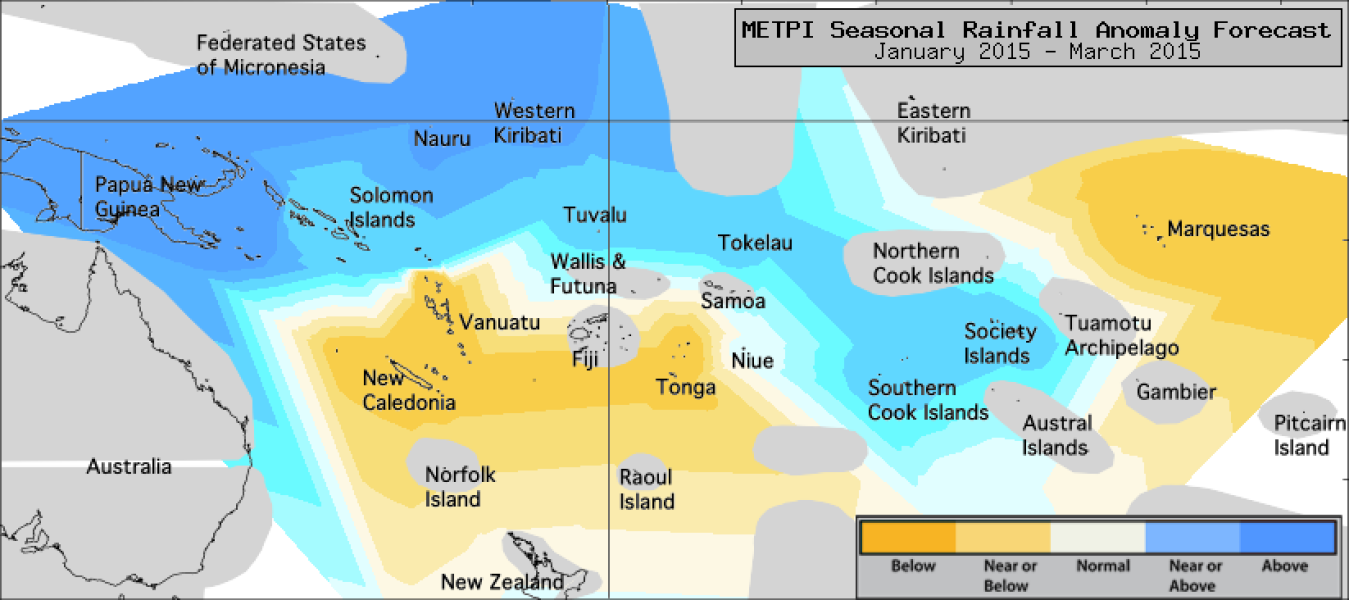In December 2014, the equatorial Pacific Ocean was still just above El Niño thresholds towards the end of the month. Some – but importantly not all – atmospheric indicators also show patterns consistent with the development of a weak El Niño, however there is no significant coupling as of yet.
International guidance indicates that the chance for El Niño developing over the January – March 2015 period is about 70%. This figure has increased compared to forecasts issued last month.
Above normal rainfall is forecast for Papua New Guinea and Western Kiribati.
Normal or above normal rainfall is forecast for the Solomon Islands, Tuvalu, Tokelau, the Southern Cook Islands and the Society Islands.
Near normal rainfall is expected for Niue.
Normal or below normal rainfall is forecast for Vanuatu, New Caledonia, Tonga, and the Marquesas.
No clear guidance is available for Samoa, the Austral Islands, the Northern Cook Islands, Fiji, Eastern Kiribati, Wallis et Futuna, the Tuamotu Archepelago and the Federated States of Micronesia.
El Niño signals exist for SSTs in the global model ensemble along the Equator, and persistence of warmer-than-normal temperatures are suggested there in the coming three month period. The cool SST anomalies seen in the subtropical and mid latitudes are also forecast to diminish as summer progresses.
Normal or above normal SSTs are forecast for Eastern Kiribati, Western Kiribati, Federated States of Micronesia, the Northern Cook Islands, the Solomon Islands, Tuvalu and Tokelau.
Near normal SSTs are forecast for Niue, the Marquesas, the Austral Islands, Tonga and the Tuamotu Archipelago.
No clear guidance is offered for the remainder of the southwest Pacific in this forecast interval.
The confidence for the rainfall outlook is high. The average region–wide hit rate for rainfall forecasts issued in January is 63%, three percent lower than the long–term average for all months combined.
The figure on the bottom right presents the last six months rainfall anomalies for each Island group alongside the latest ICU rainfall forecast for the January-March 2015 period.
The past 6 months rainfall anomalies are based on the near-real-time TRMM (Tropical Rainfall Measurement Mission) merged satellite product available from http://trmm.gsfc.nasa.gov. The data has been downloaded and available on the link below:
For each Island group, the monthly value is derived from the average of all grid-points (or "pixels") in the TRMM Dataset that intersect a coastline, to ensure that the values correspond as closely as possible to rainfall on land, and excluding rainfall falling on ocean surfaces.
The climatology used has been established over the 2001 – 2012 period. The categories ("Well-below", "Below", etc) are determined according to the percentage of the normal rainfall for that month. The thresholds are indicated in the colorbar at the bottom: to give an example, "Well-below" normal rainfall means the rainfall for that month was under 40 % of the normal rainfall, "Below" normal rainfall means that between 40 and 80 % of normal rainfall was received, etc.
IMPORTANT NOTE:
Please note that, while we use the same color-scheme for the past rainfall anomalies and the ICU forecast, the type of information presented is different. In the case of the past 6 months, actual rainfall has been estimated by satellite, and the categories are well-defined by monthly estimated rainfall compared to the long-term mean. The ICU forecast, on the other hand, is probabilistic: it indicates the likelihood (percentage chance) of rainfall being at, above, or below normal for the season as a whole. When the percentage chances in two categories are close to each other, we indicate both categories: for example if the forecast is for 35 % chance of receiving below rainfall, and 40 % chance of normal rainfall, the outcome is "Normal or below".



